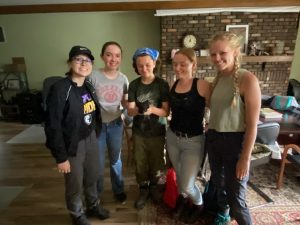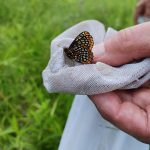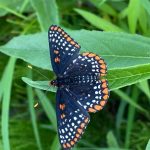
From Butterflies to Brush Saws: A Roundup of CLIP Week 2
by Arden Podpora
The second week of TLC’s internship program, CLIP, was no less eventful than the first. From butterflies to brush saws, we gained valuable skills and unforgettable experiences. This week’s blog post is brought to you by Arden: I’m one of the program interns, and I can’t wait to walk you through our week.
Monday featured a full-day trip out to the Irish Oaks preserve, where we were treated to a special plant sighting: native orchids. Who knew that orchids grew in Illinois? After brushing up on our plant ID skills for some less friendly flora, we strapped on our herbicide packs and got to spraying. It was a bad day to be Honeysuckle, Musk Thistle, Multiflora Rose or RCG (Reed Canary Grass, as it’s known by those in the biz). After wreaking mass destruction on the invasives, we took our first shot at seed collection. We targeted a hemi-parasitic plant called Wood Betony, which is used by conservation organizations to suppress dominant plant species.
Tuesday morning brought a Zoom-chat with Dave Holman, GIS (geographic information system) mapping expert extraordinaire. We learned just how critical both accessible data and human cooperation are to the conservation process, and we got to see some of the finished maps that Dave has created. From charting the quality of natural areas, to prescribed burns, to conservation easements, GIS is shaping the future of the conservation process. After saying goodbye to Dave, we headed out for an afternoon of Marsh Marigold seed collection. We had a pretty great haul at both of the sites we visited, although I’m partial to the Spring Hollow easement, where we found abundant shade and spotted a tree frog.
Wednesday morning saw the CLIP team drive out to the Hoffman Farm easement. Our program director Kim brought us along to participate in the easement monitoring process; a yearly visit is required at each property to insure no damage has been done to the land. With the easement looking good (except for a very close encounter with an asian carp), we made our way to a natural area for an afternoon of butterfly monitoring. Our guides Pete and Dennis were waiting for us when we arrived, and after a brief introduction, we ventured into the sedges. By the end of our walk, we had seen over thirty Baltimore Checkerspots!

The Checkerspot is a relatively uncommon butterfly species due to its larval dependence on a single plant: the white turtlehead. Seeing so many was an extremely cool experience–the weather, however, was anything but cool–so after our successful sightings we took a hydration break on Dennis’ porch and learned about big names in regional botany. We wrapped up the day with another outing into the preserve, where we saw native cacti (yes, cacti in Illinois!), pulled yellow sweet clover, and brought back some catnip for the office felines.
Thursday started off with our weekly workday session. We joined up with the volunteer squad at the York easement, where we all worked hard despite the heat. During a drink break we spotted a hapless toad venturing close to the clearing area, and after a quick picture, we carried him safely out of harm’s way. Since it was our second time participating in a workday, we decided it was time to break out the heavy artillery: the brush saw. The CLIPterns took turns with the saw, and almost cut down a tree holding a bald faced hornet nest! Luckily, we got away unscathed. In hot pursuit of cooler air, we had a group lunch at the nearby general store where we enjoyed malts and ice cream (thank you, Bruce!). After our meal we hit the trails at Yonder Prairie to do some seed collection, practicing plant and butterfly identification along the way.

Friday was a cooker–the hottest day of an already hot week–but we found ways to stay productive while beating the heat. With an early start the CLIP team headed out to monitor the Wonder Lake Sedge Meadow easement, where no problems meant a short visit. Our next stop was Ryders Woods Park in Woodstock; we have quickly learned that good CLIPterns need to have good plant I.D. skills, so we gathered a variety of floral clippings to add to our identification binders. One of the most interesting plants was Bedstraw, aptly named because pioneers used to use the plant to stuff their mattresses. We returned to the office to update our binders (and have lunch in the blissful air conditioning). The day continued with a reorganization of TLC’s seed barn, a task that was interrupted by a surprise visitor: restoration ecologist Megan Oropeza had rescued an injured crow from a wire fence! Dubbed “Finnegan”, the crow was a surprisingly calm visitor, and posed handsomely for a photo op before heading to a wildlife rehabilitation center nearby. We finished up the day with an academic discussion of the article “Nature and Structure of the Climax” by Frederick E. Clements, and the assignment of next week’s article, “The Individualistic Concept of Plant Association,” by H. A. Gleason.
In short, it was another great week for the CLIPterns–full of working, learning, exploring, and connecting with some absolutely incredible people. Stay tuned for next week’s blog post which will feature a new CLIPtern author.


